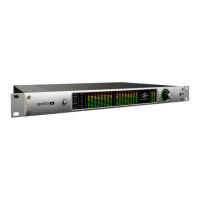Apollo 16 Hardware Manual Introduction 7
About Realtime UAD Processing
Apollo 16 has the ability to run UAD Powered Plug-Ins in realtime. Apollo 16’s groundbreaking DSP + FPGA
technology enable UAD Powered Plug-Ins to run with latencies in the sub-2ms range, and multiple UAD plug-
ins can be “stacked” in series without incurring additional latency. Realtime UAD Processing facilitates the
ultimate sonic experience while monitoring and/or tracking.
Note: Apollo 16, like other UAD-2 devices, can only load UAD Powered Plug-Ins which are specifically
designed to run on UAD-2 DSP accelerators. “Native” plug-ins cannot run on the UAD-2 DSP.
Console
Realtime UAD Processing is a special function that is available only within the Console application. All of
Apollo 16’s analog and AES/EBU inputs can perform Realtime UAD processing simultaneously, and Console
inputs with (or without) Realtime UAD Processing can be routed into the DAW for recording.
For complete details about Console and Realtime UAD Processing, refer to the Apollo Software Manual (see
“About Apollo 16 Documentation” on page 8).
UAD plug-ins in the DAW
UAD Powered Plug-Ins can also be used within the digital audio workstation without the use of Console. UAD
Powered Plug-Ins loaded within the DAW operate like other (non-UAD) plug-ins, except the processing occurs
on the Apollo 16 DSP instead of the host computer’s processor. In this scenario, UAD plug-ins are subject to the
latencies incurred by I/O buffering.
For complete details about using UAD Powered Plug-Ins in the DAW, refer to the UAD System Manual (see
“About Apollo 16 Documentation” on page 8).
Combining with other UAD-2 devices
Apollo 16 can be used simultaneously with UAD-2 devices in the same host computer system. Apollo 16 simply
adds to the DSP availability when used with other UAD-2 devices, increasing the DSP processing power so more
UAD Powered Plug-Ins can be used. Up to six UAD-2 devices can be combined in the same system.

